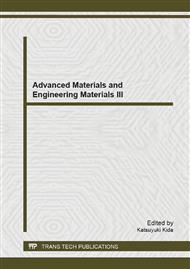[1]
N. Tomac and K. Tonnessen, Machinability of particulate aluminium matrix composites, Ann. CIRP. 41 (1) (1992), 55–58.
DOI: 10.1016/s0007-8506(07)61151-2
Google Scholar
[2]
J.E. Allison, G.S. Cole, Metal matrix composite in the automotive industry, opportunities and challenges, JOM (1993) 19–24.
DOI: 10.1007/bf03223361
Google Scholar
[3]
L. Cronjager, D. Meister, Machining of fibre and particle-reinforced aluminium, Ann. CIRP 41 (1) (1992) 63–66.
DOI: 10.1016/s0007-8506(07)61153-6
Google Scholar
[4]
L.A. Loony, J.M. Monaghan, P. O'Reilly, D.R.P. Toplin, The turning of an Al/SiC metal matrix composite, J. Mater. Process. Technol. 33 (4) (1992) 453–468.
Google Scholar
[5]
K. Weinert, W. Konig, A consideration of tool wear mechanism metal matrix composite (MMC), Ann. CIRP 42 (1) (1993) 95–98.
DOI: 10.1016/s0007-8506(07)62400-7
Google Scholar
[6]
A. Manna B. Bhattacharyya, A study on machinability of Al/SiC-MMC, J Mater Process Tech. 140 (2003) 711-716.
Google Scholar
[7]
D.K. Dwivedi, A. Sharma and T.V. Rajan, Machining of LM13 and LM28 cast aluminium alloys: Part I, J Mater Process Tech. 196 (2008) 197-204.
DOI: 10.1016/j.jmatprotec.2007.05.032
Google Scholar
[8]
S. Kannan and H.A. Kishawy, Tribological aspects of machining aluminum metal matrix composites, J Mater Process Tech. 198 (2008) 399-406.
DOI: 10.1016/j.jmatprotec.2007.07.021
Google Scholar
[9]
Dhar NR, Paul S, Chattopadhyay AB. Machining of AISI 4140 steel under cryogenic cooling – tool wear, surface roughness and dimensional deviation. J Mater Process Technol 2002; 123: 483–9.
DOI: 10.1016/s0924-0136(02)00134-6
Google Scholar
[10]
Paul S, Dhar NR, Chattopadhyay AB. Beneficial effects of cryogenic cooling over dry and wet machining on tool wear and surface finish in turning AISI 1060 steel. J Mater Process Tech. 116 (2001) 44–48.
DOI: 10.1016/s0924-0136(01)00839-1
Google Scholar
[11]
Hong SY, Markus I, Jeong W. New cooling approach and tool life improvement in cryogenic machining of titanium alloy Ti–6Al–4V. Int J Mach Tools Manuf . 41 (2001) 2245–2260.
DOI: 10.1016/s0890-6955(01)00041-4
Google Scholar
[12]
M. Dhananchezian,M. Pradeep Kumar Cryogenic turning of the Ti–6Al–4V alloy with modified cutting tool inserts. Cryogenics 2011; 51: 34–40.
DOI: 10.1016/j.cryogenics.2010.10.011
Google Scholar
[13]
B. Dilip Jerold and M. Pradeep Kumar: Experimental comparison of carbon-dioxide and liquid nitrogen cryogenic coolants in turning of AlSI 1045 steel' in , Cryogenics 52 (2012) 569–574.
DOI: 10.1016/j.cryogenics.2012.07.009
Google Scholar
[14]
Çakir O, Kiyak M, Altan E. Comparison of gases applications to wet and dry cuttings in turning. J Mater Process Tech. 2004; 153–154: 35–41.
DOI: 10.1016/j.jmatprotec.2004.04.190
Google Scholar
[15]
Liu J, Han R, Sun Y. Research on experiments and action mechanism with water vapor as coolant and lubricant in Green cutting. Int J Mach Tools Manuf. 45 (2005) 687–694.
DOI: 10.1016/j.ijmachtools.2004.09.022
Google Scholar


